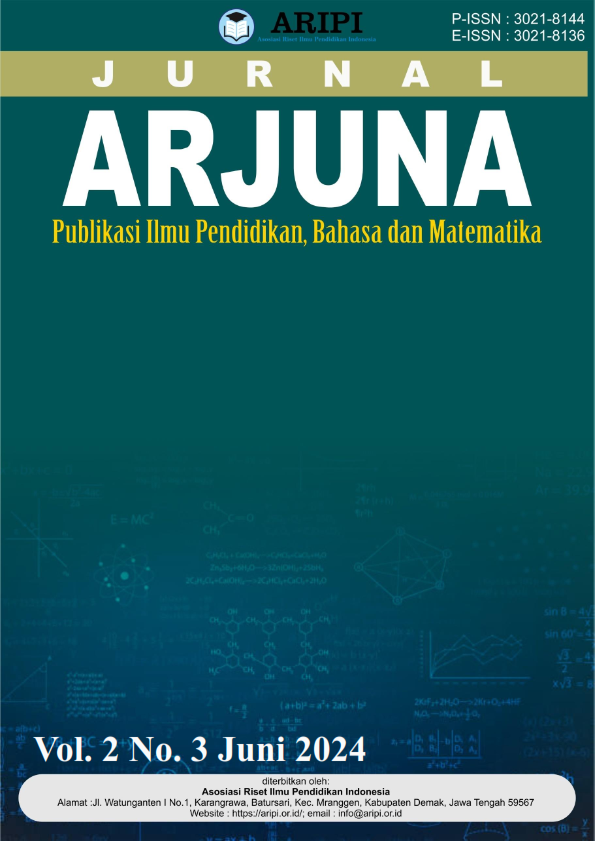Analisis Studi Literatur Kemampuan Berpikir Komputasi Menggunakan Software Matematika di SMA
DOI:
https://doi.org/10.61132/arjuna.v2i3.874Keywords:
Mathematics Education, Computational Thinking Skills, High School Mathematics Software, ProgrammingAbstract
In the era of increasing digitalization, the integration of technology in education is becoming increasingly important. One area that has received a major contribution from technology is mathematics education at the secondary school (SMA) level. The use of mathematics software has become a highly effective tool for teachers and students in understanding complex mathematical concepts, developing computational skills, and solving problems more efficiently and interactively. This article analyzes various literature studies related to the use of mathematics software in high school, with a focus on developing students' computational thinking abilities. Computational thinking (CT) abilities, which were first introduced by Seymour Papert, are important skills that help students in decision making and problem solving. Various studies show that the integration of CT in educational curricula, particularly through teaching programming and the use of mathematical software, can improve students' computing skills. Although there are challenges in implementation, such as lack of infrastructure and teacher training, this study highlights the importance of using technology in mathematics education to create a dynamic, interactive, and relevant learning environment. This research aims to provide a comprehensive analysis of literature studies related to the use of mathematics software in high school and its influence on the development of students' computational thinking skills. By understanding the findings from previous studies, it is hoped that this research can make a significant contribution to designing a more effective mathematics curriculum and provide practical guidance for educators in integrating mathematics software in everyday learning. The results of the analysis show that technology-based interactive learning methods, the use of special software such as Matlab and Geogebra, as well as programming training with languages such as Java and Python, all show positive results in improving students' computing skills. However, there is still a need to improve abstract thinking skills and address variations in computational abilities among students.
Downloads
References
Ansori, M. (2020). Pemikiran komputasi (computational thinking) dalam pemecahan masalah. Dirasah: Jurnal Studi Ilmu Dan Manajemen Pendidikan Islam, 3(1), 111–126. https://doi.org/10.29062/dirasah.v3i1.83
Aprilia, N. R. (2023). Analisis studi literatur eksplorasi algoritma pemrograman mahasiswa pendidikan matematika di era Society 5.0 dengan bibliometrik. 1(5).
Ardiningtyas, M., Harahap, T. H., & Panggabean, E. M. (2023). Penerapan teori Piaget dalam pembelajaran matematika di sekolah menengah atas: Studi kasus di sekolah SMA Negeri 3 Medan. Tut Wuri Handayani: Jurnal Keguruan Dan Ilmu Pendidikan, 2(2), 66–71. https://doi.org/10.59086/jkip.v2i2.294
Cahdriyana, R. A. (2020). Berpikir komputasi dalam pembelajaran matematika. XI(1), 33–35.
Kartika, H. (2014). Pembelajaran matematika berbantuan software Matlab sebagai upaya meningkatkan kemampuan komunikasi matematis dan minat belajar siswa SMA. Jurnal Pendidikan Unsika, 2(1), 21–33. https://journal.unsika.ac.id/index.php/judika/article/view/119
Lestari, S., & Roesdiana, L. (2023). Analisis kemampuan berpikir komputasional matematis siswa pada materi program linear. RANGE: Jurnal Pendidikan Matematika, 4(2), 178–188. https://doi.org/10.32938/jpm.v4i2.3592
Malik, A. M., Kristanti, F., & Soemantri, S. (2023). Studi meta-analisis: Model pembelajaran kooperatif terhadap kemampuan berpikir kritis. 16, 118–136.
Malik, S., Prabawa, H. W., & Rusnayati, H. (2019). Peningkatan kemampuan berpikir komputasi siswa melalui multimedia interaktif berbasis model quantum teaching and learning. International Journal of Computer Science Education in Schools, 8(November), 41. https://doi.org/10.13140/RG.2.2.34438.83526
Matematika, J. P., Ilmu, F., Dan, T., & Syarif, N. (2023). Efektivitas pendekatan diskursus matematik terhadap kemampuan berpikir komputasional matematis siswa.
Qurohman, M. T., Afriliana, I., & ... (2022). Peningkatan kemampuan komputasi matematika siswa MAN 1 Brebes menggunakan software Matlab mobile. Martabe: Jurnal ... 5, 2403–2407. http://jurnal.um-tapsel.ac.id/index.php/martabe/article/view/7714
Telaumbanua, Y. N. (2020). Analisis pembelajaran dengan menggunakan software Geogebra dalam pembelajaran matematika. J-PiMat: Jurnal Pendidikan Matematika, 2(1), 131–138. https://doi.org/10.31932/j-pimat.v2i1.683
Wiryasaputra, R., Salomo, A., Sevani, N., & Seruni. (2022). Peningkatan pola berpikir komputasi pada siswa/i SMAK Mater Dei melalui bahasa pemrograman Java dan Python. Servirisma, 2(2), 127–145. https://doi.org/10.21460/servirisma.2022.22.28
Downloads
Published
How to Cite
Issue
Section
License
Copyright (c) 2024 Jurnal Arjuna : Publikasi Ilmu Pendidikan, Bahasa dan Matematika

This work is licensed under a Creative Commons Attribution-ShareAlike 4.0 International License.






